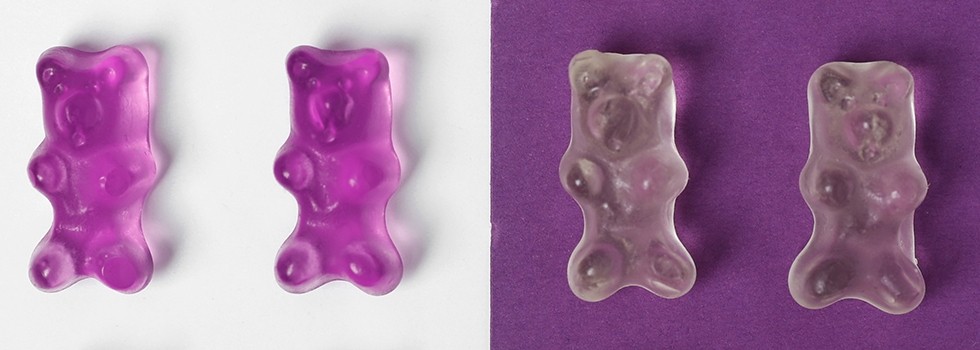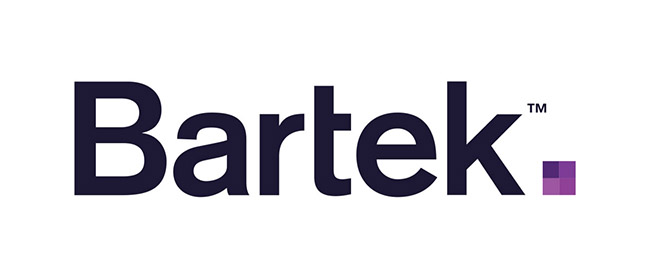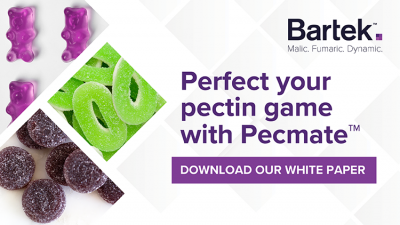Promotional Features
New Ingredient Optimizes Pectin-based Gel Production
Everywhere you turn, plants are replacing animal-based ingredients. And after long avoiding it, the plant-based movement has entered the confectionery space. Some of the most compelling opportunities to gain shelf space and grow market share in this space are now in replacing gelatin, an animal-based ingredient, with pectin in popular formats.
Gummy and soft candy applications are no strangers to this trend. Between 2015 and 2020, pectin led the way in new soft confectionery product launches where a vegan or no-animal ingredient claim was made. Approximately 46% of new product launches in that time frame included pectin as the top ingredient.
Soft, chewy candy applications traditionally utilized gelatin, an animal-based gelling agent, but are lately seeing rising competition from pectin-based alternatives. With so many consumers making the switch to consuming more plant-based foods, many brands too are making the switch from gelatin to pectin as a gelling agent. While pectin can be helpful for maintaining a plant-based label claim, its gelling parameters are much narrower than gelatin – and, as many formulators are finding, much more challenging.
Pectin: Demand from consumers creates demanding challenges for formulators
Despite this impressive growth and strong market advantage, anyone who has worked with pectin knows that it can be a perplexing ingredient for even the most seasoned brands and formulators. Fluctuations in temperature, percentage of solids, and pH can cause pectin-based formulations to set too early, form a weak gel, or fail to set at all.
To have pectin set properly, three conditions must be met:
- Depositing temperature should be at 180 °F
- The final pH should be in the 3.4-3.6 pH range
- The solids percentage should be in the range of 78-82 Brix
While depositing temperature and solids percentage are easier to control, controlling the pH can be often overwhelming. The challenges of working with pectin are currently managed mostly with sodium citrate – a sub-optimal buffer for pectin’s gelling range of pH 3.2 to 3.6. Additionally, introducing flavors and coloring agents can destabilize the pH.
Where gelatin can be remelted and reworked if mistakes occur or it fails to properly set, pectin cannot. Inconsistent gelling in pectin can result in scrapping an entire production run. Maintaining a stable pH is not simple, and losing an entire batch is costly for manufacturers.
How to make pectin work with your formulation – not against it
In response to the challenges that plant-based confections formulators face, Bartek has created Pecmate™ Pectin Enhancer: a functional ingredient designed to address well-known challenges in the production of pectin-based gummy products. This innovation gives producers greater control over gelling conditions in commercial scale gummy production. Lower preset incidence translates to higher throughput, reduced loss to scrap, and less costly downtime on the production line. Pecmate™ makes pectin a more forgiving gelling agent. Candies stay fluid when needed and set up when initiated – not before.
In production tests, gummy candy formulations made with Pecmate™ outperformed those made with another leading gelling acidulant: test data showed that the gummies with Pecmate™ added to malic acid or citric acid enabled the producer to realize more optimal gelling activity and better control over set time than formulations made with sodium citrate alone. With more control over the pH parameters, gummies in the test batches not only set in an ideal amount of time, but finished candies also had the desired texture, as intended, and cleanly released from the candy molds.
A better pectin formulation experience for a better overall product
Formulating with Pecmate™ benefits all stakeholders. The confectioner gets the gummy or soft candy application they set out to make. End consumers get a high quality, uniformly consistent experience with well-rounded flavor profile, forming the foundation for repeat sales and brand loyalty. And for the gummy manufacturer, reduced loss to scrap contributes to more time for new product development, less wasted costs, and more efficiencies in labor utilization.
At Bartek, we pride ourselves in being the experts in strategically putting acidulants to work to create the best confectionery products possible. Our years of experience with acidulants and functional salts for food and beverage applications has taught us that pH is everything in formulations. Gummy and soft candy applications perfectly illustrate the effects of even incremental fluctuations in pH during production.
With Pecmate™, producers wield more control over pH at every stage of the manufacturing process. By reducing the risk of pre-setting, Pecmate™ empowers formulators in ways that using sodium citrate alone as a gelling acidulant cannot. Producers using acidulants for confectionery and supplement applications can visit bartek.ca to learn more about Pecmate™ and other innovations from Bartek.



